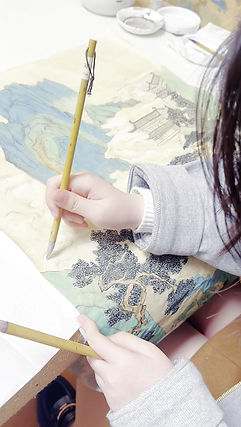
An empty mountain, washed by fresh rain
Cathy Shen, 2024
Chinese Traditional Painting
Theme: Blue and Green Landscape
Technique: Freehand (Xieyi)
Material: 90% Matured Xuan Paper

Sailing the boat on green waters ahead
Cathy Shen, 2023
Chinese Traditional Painting
Theme: Blue and Green Landscape
Technique: Freehand (Xieyi)
Material: 90% Matured Xuan Paper

Thirty Thousand Miles to Chang'an
Cathy Shen, 2025
Chinese Traditional Painting
Theme: Blue and Green Landscape
Technique: Freehand (Xieyi)
Material: 100% Matured Xuan Paper
The Blue-Green Landscape painting
Blue-Green Landscape painting represents one of China's most visually striking traditions in art, characterized by its brilliant use of mineral pigments—particularly azurite and malachite—that create luminous blues and greens against golden and ochre backgrounds. This distinctive style emerged during the Wei-Jin period and flourished in the Sui-Tang era under masters like Zhan Ziqian and Li Sixun, who established what would become known as the gold-and-blue-green landscape tradition. The technique reached its zenith during the Song Dynasty with Wang Ximeng's masterpiece "A Thousand Li of Rivers and Mountains," where layers of translucent color over warm earth tones achieved an almost jewel-like intensity that has captivated viewers for centuries. As the style evolved through successive dynasties, it absorbed new influences: Yuan Dynasty scholar-artists like Zhao Mengfu infused it with literati sensibilities, Ming masters such as Qiu Ying and Zhang Hong grounded it in observed reality, and Qing decorative painters like Yuan Yao pushed its ornamental possibilities to new heights.

A Thousand Li of Rivers and Mountains
Wang Ximeng
Northern Song Dynasty around 1113 CE
The tradition encompasses two main approaches—the "grand" style, which employs bold, opaque colors with precise outlines and minimal texture strokes, and the "small" style, which delicately layers translucent washes over ink underpaintings. From the meticulous techniques refined during the Six Dynasties period to the revolutionary splashed-color methods pioneered by modern master Zhang Daqian, this tradition has continuously reinvented itself while maintaining its essential character: the transformation of ground minerals through careful preparation with binding agents into paintings of extraordinary luminosity and depth, exemplified in timeless works from Zhan Ziqian's "Spring Excursion" to contemporary explorations that continue to push the boundaries of this ancient yet ever-evolving art form.

Blue-Green Landscape Scroll
Qiu Ying
Ming Dynasty
An empty mountain, washed by fresh rain
This painting of mine exemplifies the "small blue-green" style. I first used ink to outline the texture of the rocks and trees, then layered malachite and azurite over a warm, cream-colored ground, allowing the underlying tones to illuminate the cooler pigments from within. The composition unfolds in a series of ascending rocky forms. These distinctive formations dominate the middle ground, their blue-green masses anchored by darker pine trees that cling to their slopes and summits. To create a sense of recession, I applied increasingly pale washes in the background, where distant peaks dissolve into the paper's natural tone. By using water to transcend boundaries, I established an atmospheric perspective that diverges from Western conventions of linear perspective.
Among the vast landscapes appear some small pavilions with upturned roofs. A solitary figure, rendered in a few brushstrokes, traverses a winding path that threads through the lower portion of the composition. Through this careful choice of position, I aimed to establish the concept of the classical Chinese ideal, which posits mankind's humble place within the natural world. This tiny presence, though unattractive at first glance, proves my aim to transform the landscape from mere scenery into a space for deeper contemplation, as emphasized in Taoism, which has long advocated for a simple life close to nature.
Sailing the boat on green waters ahead
This painting represents a markedly different approach to Chinese landscape, as I employed a more restrained palette dominated by warm ochres and pale yellows with selective applications of muted green. I created a horizontal composition in which the distinctive rock formations were built up primarily through linear strokes. These parallel lines, known as "cun" (皴) strokes, follow the natural stratification of sedimentary rock while maintaining an abstract rhythm. I applied the green pigment sparingly, primarily defining vegetation that clings to the rocky slopes. The application of green pigments on the otherwise yellowish landscapes demonstrates the selective use of color, which reflects the principle of "reserving color for emphasis," where chromatic elements guide the viewer's attention through an otherwise monochromatic composition.
Furthermore, the calligraphic inscription and red seals in the lower right corner narrate the inner thoughts of the visitors on the small boat. It tells explicitly, “We are visitors outside the cyan mountains; we drive the boat in front of the greenish streams.” The vertical arrangement of the text is conventional in Chinese calligraphy.
Thirty Thousand Miles to Chang'an
Watch the vedio on the right for more...

Overall, this artwork of mine embodies the "xieyi" (写意) or "idea-writing" tradition, where capturing the spirit and essence of the landscape takes precedence over detailed representation, resulting in a work that feels both spontaneous and deeply contemplative —a personal meditation on place rendered in ink and subtle color.


